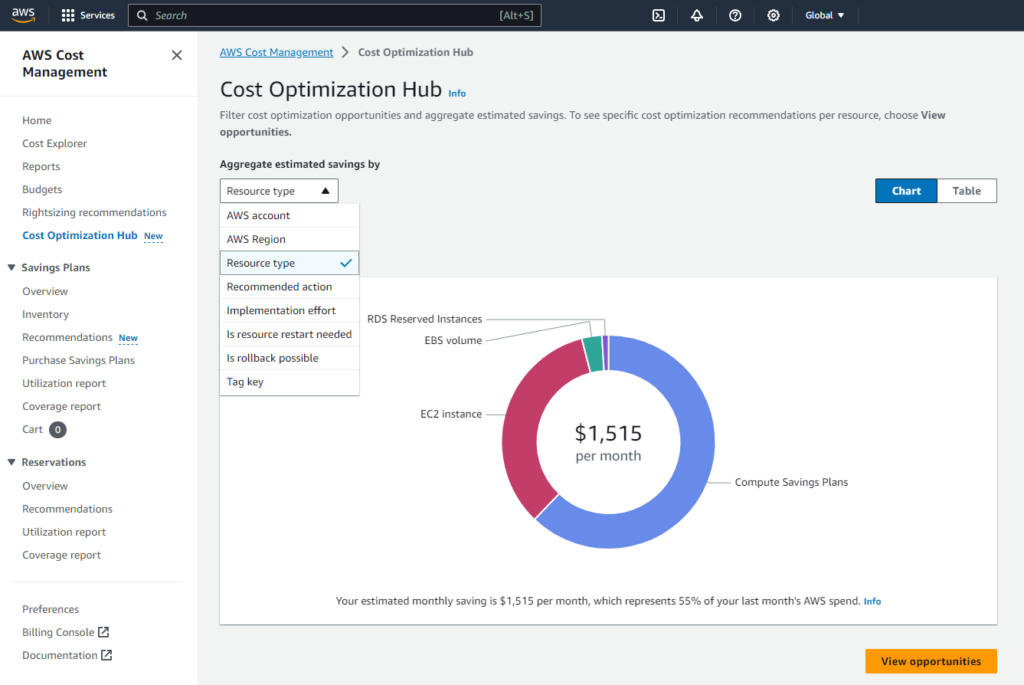According to the FinOps Foundation’s 2025 State of FinOps Report, out of the survey’s 861 respondents, more than 50% responded “workload optimization and waste reduction” as their top priority. That’s a clear signal that cloud cost optimization is still a major challenge.
Cloud optimization isn’t merely about cutting costs; it’s about ensuring every dollar spent drives value. Without a structured approach, your organization risks missing out on discount opportunities, paying for unused resources, and struggling to align cloud investments with your business goals. This is why cloud cost optimization is no longer a luxury, it’s a necessity.
AWS offers a solution in the form of AWS Cost Optimization Hub — a centralized tool designed to surface personalized cost-saving recommendations based on your actual usage patterns. But how effective is it? What types of optimizations does it suggest? And how can businesses use it to maximize savings without compromising performance?
In this guide, we break down what AWS Cost Optimization Hub offers, the recommendations it provides, and key factors to consider before integrating it into your cost management strategy.
What Is AWS Cost Optimization Hub?

Image Source: AWS Blog
AWS Cost Optimization Hub is a built-in centralized tool designed to help businesses identify and act on cost-saving opportunities across their cloud environment. It consolidates 15+ types of cost optimization recommendations — including rightsizing instances, terminating idle resources, and leveraging Savings Plans or Reserved Instances (RIs), all into a single, streamlined dashboard.
As a free feature of AWS Billing and Cost Management, the Hub provides centralized visibility into where and how you can reduce costs, along with estimated monthly savings for each recommendation. Instead of manually analyzing cost reports or toggling between multiple AWS services, businesses can use the Cost Optimization Hub to make faster, data-driven decisions to eliminate waste, improve efficiency, and maximize cloud savings.
Key Benefits of AWS Cost Optimization Hub
Here’s a closer look at five benefits AWS Cost Optimization Hub can offer businesses looking to maximize their AWS return on investments:
Detect and centralize AWS cost-saving opportunities
The Cost Optimization Hub aggregates insights from multiple AWS services (including AWS Cost Explorer, Compute Optimizer, Trusted Advisor, and AWS Budgets) into one centralized and deduplicated dashboard. This eliminates the need to analyze cost data across multiple AWS services, providing a unified view of potential savings.
Estimate savings with AWS pricing and discounts
By analyzing historical spending and usage patterns, the Hub estimates potential savings before implementation. First, it uses AWS Cost Explorer and AWS Compute Optimizer to assess your organization’s current spending patterns. Then, it predicts how much you could save by implementing different cost-saving opportunities, such as eliminating idle resources, or shifting to commitment-based pricing.
Compare cost optimization strategies
The Hub allows businesses to compare different cost-saving approaches side by side, estimating savings for each strategy. This helps businesses make optimization choices that maximize cost savings without impacting performance.
For example, a business deciding between scaling down resources to reduce immediate costs or committing to a long-term pricing model for sustained savings can use the Hub to compare both options.
By estimating the financial impact of each approach, they can determine whether short-term flexibility or long-term commitment aligns better with their cost optimization goals.
Access prioritized recommendations with actionable insights
The AWS Cost Optimization Hub doesn’t just surface cost-saving opportunities; it also provides key context to help teams assess feasibility before taking action. Each recommendation includes details such as the implementation effort required, whether a resource restart is needed, and if a rollback is possible. This helps practitioners triage optimizations based on operational constraints, minimizing risk while maximizing savings.
Users can also sort and filter recommendations based on several key factors, including:
- Resource type & ID: Identify which AWS services and specific resources are affected.
- Top recommended action: See the most impactful optimization step for each resource.
- Current vs. recommended resource summary: Compare existing configurations with suggested improvements.
- Estimated savings percentage & monthly cost impact: Quantify the financial benefit of each recommendation.
- Implementation effort & rollback feasibility: Assess complexity before making changes.
- Account ID, region, & tags: Filter recommendations across multi-account AWS environments.
By providing these insights in a single dashboard, the Hub allows businesses to make informed, low-risk cost optimizations while ensuring operational continuity.
What Types of Recommendations Does the AWS Cost Optimization Hub Offer?
The Cost Optimization Hub generates recommendations for 15 types of resources including EC2 instances, Auto Scaling groups, EBS volumes, Lambda functions, and various Savings Plans and Reserved Instances.
For a detailed breakdown of all supported resources, check out the full list on AWS documentation.
For easy navigation, the Hub organizes these recommendations into eight cost optimization strategies — let’s take a detailed look:
Rightsize
Rightsizing optimizes resource allocation by adjusting over-provisioned resources to the right-sized configuration based on actual usage patterns while maintaining optimal performance.

Image Source: AWS Blog
The Cost Optimization Hub consolidates rightsizing recommendations by identifying over-provisioned instances and suggesting optimized configurations that better align with workload demands. It highlights which instances can be downsized while maintaining performance, ensuring no wasted capacity or unnecessary compute costs.
Upgrade
The Hub detects outdated AWS resources, such as older EC2 instances, EBS volumes, and RDS databases, and recommends upgrades to newer, more cost-efficient alternatives. By modernizing infrastructure, businesses can improve performance-to-cost ratios, reduce maintenance overhead, and enhance reliability.
Graviton migration
Another way to improve performance while driving cost savings is migrating from x86-based instances to Graviton-based instances. Compared to x86-based instances, Graviton-based instances offer up to 40% better price performance and consume up to 60% less energy, which means lower overall compute costs.
The Cost Optimization Hub can highlight where you can make the switch in your AWS environment to maximize savings.
Stop
The Hub identifies unused AWS resources — such as EC2 instances, Lambda functions, and Auto Scaling groups and flags them for potential stoppage. This helps businesses eliminate cloud waste from non-essential workloads that continue running without active usage.
Delete
The Cost Optimization Hub identifies long-idle storage and compute resources that continue to incur costs despite being unused. It highlights EBS volumes, snapshots, and orphaned resources that can be deleted to eliminate waste and reduce cloud spend.
For example, EBS snapshots on a 100GB volume can cost anywhere from about $5 per month up to $80 per month, depending on snapshot frequency and data churn between snapshots. When accumulated across hundreds of outdated snapshots, businesses may unknowingly spend thousands in unnecessary storage fees.
Similarly, detached but undeleted EBS volumes continue incurring costs even when not in use. By surfacing these inefficiencies, COH helps businesses clean up inactive resources and prevent avoidable storage costs.
Scale in
The Cost Optimization Hub centralizes scale-in recommendations specifically for Auto Scaling Groups (ASGs). ASGs automatically scale out when demand increases, provisioning additional instances to handle workloads. However, as demand decreases, failing to scale in, leads to unnecessary costs from over-provisioned instances.
COH helps optimize this process by identifying when ASGs have excess capacity and recommending reductions to align with actual workload demand. This helps ensure cost-efficiency while ensuring performance remains stable.
Purchase Savings Plans
AWS Cost Optimization Hub also presents Savings Plans recommendations, allowing businesses to secure discounted pricing for long-term workloads. It provides side-by-side comparisons of different plans.
For example, depending on your AWS environment, it might recommend Compute Savings Plans, EC2 Instance Savings Plans, or SageMaker Savings Plans to help you secure long-term cost savings via commitment-based pricing.
As part of its recommendations, it compares commitment terms (1-year vs. 3-year) and payment options (full, partial, or no upfront), generating cost-comparison reports that show potential savings for each plan. This helps businesses make informed decisions on the most cost-effective option for their cloud infrastructure.
Purchase Reserved Instances
The Hub aggregates Reserved Instance recommendations, showing businesses where they can save by committing to discounted pricing for predictable workloads.
Similar to Savings Plan recommendations, it helps businesses compare RI commitment terms (1-year vs. 3-year), payment options (full, partial, or no upfront), and RI types (Standard vs. Convertible) to identify the most cost-effective option for their needs — all within a centralized view.
Considerations for Using AWS Cost Optimization Hub
Before using AWS Cost Optimization Hub, here are key factors to consider:
AWS-centric focus
The Hub is designed exclusively for AWS environments. If your organization operates in a hybrid or multi-cloud setup, additional third-party tools will be required for full visibility, which might result in added cost and complexity.
Manual implementation required
The Cost Optimization Hub provides detailed insights and recommendations for AWS environments, but it does not implement these recommendations — that’s up to your teams.
This means teams must analyze recommendations, assess feasibility, and implement changes themselves, which can be time-consuming — especially for organizations managing large-scale cloud environments.
While this isn’t a limitation of the Hub itself, it does pose a challenge: Cost optimization efforts can divert engineering teams from their primary KPIs, such as innovation, product development, and system performance.
Learning curve for new users
Effectively using the Hub requires a solid understanding of AWS pricing models, resource configurations, and cost optimization strategies. Without prior experience, interpreting its recommendations and navigating the dashboards can be challenging.
Additionally, acting on these insights isn’t always straightforward, some optimizations require complex engineering decisions that go beyond simple configuration changes. Teams must not only evaluate cost-saving recommendations but also ensure they align with performance, scalability, and business needs, making expertise in cloud cost management essential.
Pricing
AWS Cost Optimization Hub is free for AWS users and integrates with services like Cost Explorer, Compute Optimizer, and Trusted Advisor. However, premium features in these services and third-party tools for multi-cloud environments may come at an additional cost.
Improve Your AWS Cost Optimization With ProsperOps

AWS Cost Optimization Hub offers valuable cost-saving insights, but acting on them requires manual effort, ongoing monitoring, and cloud cost expertise.
For true cost optimization, automation is key. This is where ProsperOps comes in!
ProsperOps delivers cloud savings-as-a-service, automatically blending discount instruments to maximize your savings while lowering commitment lock-in risk. Using our autonomous discount management platform, we optimize the hyperscaler’s native discount instruments to reduce your cloud spend and place you in the 98th percentile of FinOps teams.
This hands-free approach to AWS cost optimization can save your team valuable time while ensuring automation continually optimizes your AWS discounts for maximum Effective Savings Rate (ESR).
Make the most of your AWS cloud spend with ProsperOps. Schedule your free demo today!





